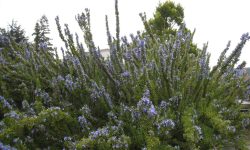Growing Lemon Balm: Tips for Cultivating and Caring for this Herb
Lemon balm, a versatile herb with a refreshing citrus scent, is a must-have addition to any garden. In this blog post, we will guide you through the process of successfully growing and maintaining lemon balm plants. Whether you are a beginner or an experienced gardener, we will cover everything you need to know from choosing the right location and preparing the soil to planting seeds or transplants. We will also discuss the importance of providing adequate watering and drainage, as well as tips for maintaining and harvesting your lemon balm plants. So, let’s dive in and get started on your lemon balm journey!
Choosing the Right Location for Lemon Balm
Lemon balm, also known as Melissa officinalis, is a delightful herb that offers a plethora of benefits. Whether you’re a seasoned gardener or a beginner, choosing the right location for your lemon balm plants is crucial for their optimal growth and development.
When it comes to selecting the perfect spot for your lemon balm, there are a few key factors to consider. Firstly, it’s important to find a location that receives ample sunlight. Lemon balm thrives in full sun, so aim for at least 6-8 hours of direct sunlight each day.
In addition to sunlight, lemon balm also prefers a well-drained soil. It’s crucial to ensure that water does not accumulate around the roots, as this can lead to root rot or other diseases. Consider planting your lemon balm in raised beds or adding organic matter, such as compost or well-rotted manure, to improve drainage.
Beyond light and soil conditions, it’s also essential to think about proximity. Ideally, you want to choose a location that is easily accessible. This will make it convenient for you to tend to your lemon balm plants, whether it’s watering, pruning, or harvesting.
- Ensure ample sunlight for your lemon balm plants
- Opt for a well-drained soil to prevent root rot
- Consider proximity and accessibility for easier maintenance
| Factors to Consider | Best Conditions |
|---|---|
| Sunlight | Full sun (6-8 hours per day) |
| Soil Drainage | Well-drained soil with added organic matter |
| Proximity | Easily accessible for maintenance tasks |
By taking these factors into account and selecting a location that fulfills these requirements, you’ll ensure that your lemon balm plants grow vigorously and produce a bountiful harvest. Happy gardening!
Preparing the Soil for Lemon Balm Planting
Lemon balm is a popular herb known for its many uses in the culinary and medicinal world. Whether you want to grow it in your garden or in pots, preparing the soil is an essential step before planting. Good soil preparation ensures that your lemon balm plants will thrive and produce a bountiful harvest. In this blog post, we will discuss the importance of soil preparation and provide you with some helpful tips to get started.
First and foremost, it’s crucial to choose a location with adequate sunlight for your lemon balm plants. Lemon balm thrives in full sun to partial shade, so select an area that receives at least 6 hours of direct sunlight per day. Once you have found the perfect spot, it’s time to assess the soil and make necessary amendments.
1. Test your soil: Before planting lemon balm, it’s essential to know the pH level and nutrient content of your soil. You can purchase a soil testing kit from a local garden center or send a sample to a professional lab for analysis. The results will tell you if your soil is acidic, neutral, or alkaline, enabling you to adjust the pH accordingly.
2. Improve drainage: Lemon balm prefers well-draining soil to prevent root rot and other water-related issues. To improve drainage, you can incorporate organic matter such as compost or well-rotted manure into the soil. This will not only enhance the soil structure but also increase its ability to retain moisture while allowing excess water to drain away.
3. Add nutrients: Lemon balm thrives in fertile soil, so it’s essential to provide it with the necessary nutrients. You can enrich the soil by adding organic fertilizers like compost, aged manure, or worm castings. These natural fertilizers not only nourish the plants but also improve the overall soil health and fertility.
4. Remove weeds: Before planting lemon balm, make sure to remove any existing weeds or grass from the planting area. Weeds can compete with your lemon balm plants for nutrients and water, hampering their growth. Regular weeding is also recommended throughout the growing season to keep the area clean and weed-free.
Once you have prepared the soil following these steps, you are ready to plant your lemon balm seeds or transplants. Remember to space the plants adequately and water them thoroughly after planting. Proper soil preparation will lay the foundation for healthy and vigorous lemon balm plants, ensuring a successful and abundant harvest.
Planting Lemon Balm Seeds or Transplants
Lemon balm is an aromatic herb that is known for its soothing properties and refreshing scent. Whether you choose to plant lemon balm seeds or transplants, it’s important to follow the proper techniques to ensure a successful and thriving plant. In this blog post, we will explore the steps to plant lemon balm seeds or transplants, so you can enjoy this delightful herb in your garden.
Before you begin planting lemon balm seeds or transplants, it’s crucial to choose the right location for optimal growth. Lemon balm prefers a sunny spot with well-draining soil. It can tolerate partial shade, but too much shade can affect its growth and flavor. Ensure that the location you choose provides at least 6 hours of direct sunlight daily. This will help the plants to establish well and produce abundant foliage.
Once you have identified the perfect location, it’s time to prepare the soil for planting. Lemon balm thrives in fertile soil that is rich in organic matter. Begin by clearing the area of any weeds or debris. Loosen the soil with a garden fork or tiller to a depth of about 6-8 inches. Incorporate compost or well-rotted manure into the soil to improve its nutrient content and drainage. This preparation step will provide a healthy foundation for your lemon balm plants.
Now comes the exciting part – planting the lemon balm seeds or transplants. If you choose to start from seeds, sow them directly into the prepared soil about a quarter-inch deep. Space the seeds at least 12 inches apart to allow ample room for growth. Lightly water the soil after planting to ensure good seed-to-soil contact. If you opt for transplants, dig a hole that is slightly larger than the root ball of the plant. Place the transplant into the hole, making sure it is at the same depth as it was in its original container. Gently firm the soil around the transplant and water thoroughly.
Providing adequate watering and drainage is crucial for the healthy development of lemon balm plants. Water the plants regularly, especially during dry periods. It’s important to keep the soil consistently moist, but not waterlogged. Proper drainage is essential to prevent root rot and other water-related issues. Regularly check the soil moisture and adjust your watering schedule accordingly. Mulching around the plants can help retain moisture and suppress weed growth, providing additional benefits to your lemon balm plants.
Maintaining and harvesting lemon balm plants is an ongoing process. Regularly inspect the plants for pests or diseases, and take necessary actions to control them. Prune the plants regularly to encourage bushier growth. When it comes to harvesting, you can start plucking the leaves once the plant has reached a decent size. Simply pinch off the leaves as needed, or cut the stems about an inch above the ground. The freshly harvested leaves can be used immediately or dried for future use in teas, culinary dishes, or homemade herbal products.
In conclusion, planting lemon balm seeds or transplants is a rewarding experience that can provide you with a bountiful herb garden. By choosing the right location, preparing the soil properly, and providing adequate care, you can enjoy the aromatic and soothing benefits of lemon balm for years to come.
Providing Adequate Watering and Drainage
Proper watering and drainage are essential for the healthy growth and development of lemon balm plants. In this blog post, we will discuss the importance of providing adequate watering and drainage for your lemon balm plants, and how to ensure that they receive the right amount of moisture for optimal growth.
Importance of Adequate Watering:
Watering is a critical factor in the success of any plant, including lemon balm. Adequate watering ensures that the plant receives the necessary moisture to carry out its various biological processes, such as photosynthesis and nutrient absorption.
When it comes to lemon balm, it is important to maintain a balance between under-watering and over-watering. Insufficient water can cause stress to the plant, leading to stunted growth, yellowing of leaves, and reduced essential oil production. On the other hand, excessive watering can suffocate the roots and promote the growth of diseases and pests.
Tips for Watering Lemon Balm:
1. Watering Frequency: Lemon balm plants generally require regular watering to thrive. During the growing season, water your plants deeply once or twice a week to ensure that the soil remains consistently moist but not waterlogged.
2. Watering Method: Water the plants at the base rather than spraying the leaves. This helps prevent the formation of fungal diseases and ensures that the water reaches the roots where it is needed the most.
3. Monitor Soil Moisture: Regularly check the moisture level of the soil by inserting your finger about an inch deep. If it feels dry, it’s time to water. If it feels moist, hold off on watering to avoid over-saturation.
4. Consider Environmental Factors: Take into account factors such as temperature, humidity, and rainfall when determining the watering needs of your lemon balm plants. Adjust the frequency and amount of watering accordingly to maintain an optimal moisture balance.
The Role of Drainage:
Proper drainage is equally important as excessive moisture can lead to the root rot and other diseases. Lemon balm plants prefer well-draining soil that allows excess water to escape, preventing waterlogging and root suffocation.
Ensuring Good Drainage:
1. Choose the Right Soil: Use a well-draining soil mix for planting lemon balm. Sandy or loamy soil that does not retain excessive moisture is ideal. Avoid heavy clay soils that tend to become waterlogged.
2. Amend with Organic Matter: If your soil lacks drainage, consider incorporating organic matter such as compost or perlite to improve its structure and drainage capabilities.
3. Use Raised Beds or Containers: For areas with poor soil drainage, consider planting lemon balm in raised beds or containers with adequate drainage holes. This allows you to have better control over the soil composition and moisture levels.
By providing adequate watering and ensuring proper drainage, you can create an optimal growing environment for your lemon balm plants. Remember to monitor the moisture levels of the soil and adjust your watering practices accordingly. With the right care, your lemon balm plants will thrive and reward you with their delightful aroma and culinary uses.
Maintaining and Harvesting Lemon Balm Plants
Lemon balm plants, with their distinct lemony aroma and numerous health benefits, are a popular addition to many gardens. Once you have successfully planted and established your lemon balm, it’s important to know how to properly maintain and harvest these plants to ensure their continued growth and productivity. This article will guide you through the steps to effectively care for and harvest your lemon balm plants.
Maintaining Lemon Balm Plants:
1. Watering: Lemon balm plants require regular watering to thrive. Keep the soil consistently moist but not waterlogged. Water deeply at the base of the plant, ensuring the water reaches the roots. Avoid overhead watering as it can lead to fungal diseases.
2. Fertilizing: Lemon balm plants generally do not require heavy fertilization. However, you can lightly fertilize them with a balanced organic fertilizer once a year in early spring. This will provide them with the necessary nutrients to support healthy growth.
3. Pruning: Regular pruning is crucial to maintain the vigor and shape of lemon balm plants. Remove any dead or damaged leaves and stems regularly. This not only improves the appearance but also helps prevent diseases. Additionally, pinching off the tips of the stems encourages bushier growth.
4. Managing Pests and Diseases: Lemon balm plants are relatively pest and disease resistant. However, they can occasionally be attacked by aphids, spider mites, or powdery mildew. Inspect your plants regularly and take appropriate measures such as handpicking pests or applying organic pest control methods if needed.
Harvesting Lemon Balm:
1. Timing: Lemon balm leaves are most flavorful before the plant flowers. Harvest the leaves in the morning after the dew has dried but before the sun is too hot. This is when the essential oils are at their peak, resulting in the best flavor.
2. Harvesting: Simply snip the leaves and stems above a leaf node using clean, sharp scissors or pruning shears. Avoid harvesting more than one-third of the plant at a time to allow for regrowth. Selectively harvesting mature leaves will encourage new growth and ensure a continuous supply throughout the season.
3. Storing: To store harvested lemon balm leaves, gently wash them to remove any dirt or debris. Pat them dry with a paper towel and lay them in a single layer on a clean, dry surface. Allow them to air dry completely and then store them in an airtight container away from direct sunlight. Properly dried leaves can retain their flavor for up to a year.
By following these maintenance and harvesting practices, you can enjoy a flourishing lemon balm plant that provides you with a continuous supply of flavorful leaves. Remember to always use the harvested leaves promptly in your culinary endeavors or prepare them for future use by drying or freezing.
Frequently Asked Questions
What factors should I consider when choosing the right location for lemon balm?
Lemon balm prefers full sun to partial shade and well-drained soil. It’s also beneficial to select a location away from strong winds.
How should I prepare the soil for lemon balm planting?
Before planting, loosen the soil and remove any weeds or debris. Adding organic matter like compost can improve soil fertility and drainage.
Should I use seeds or transplants to grow lemon balm?
Both options are viable. Starting from seeds may require more time and care, while transplants can be easier for beginners. Choose the method that suits your preferences and needs.
How often should I water lemon balm and ensure proper drainage?
Water lemon balm regularly, keeping the soil moist but not waterlogged. Ensure good drainage to prevent root rot. Mulching can help retain moisture and regulate soil temperature.
What are some essential tips for maintaining and harvesting lemon balm plants?
Regularly trim and prune lemon balm to maintain its shape and encourage bushier growth. Harvest the leaves just before the plant flowers for the best flavor. Be sure to leave some foliage intact for plant health.
How can I deal with pests and diseases that may affect my lemon balm?
Common pests like aphids and spider mites can be controlled by spraying neem oil or using insecticidal soap. Keep an eye out for fungal diseases, such as powdery mildew, and treat with appropriate fungicides.
What are some common uses for lemon balm?
Lemon balm has various uses, including culinary purposes like teas, salads, and desserts. It’s also used in natural remedies, aromatherapy, and as a mosquito repellent. The leaves can be dried for future use.



